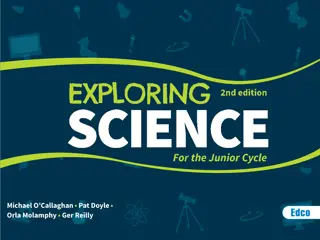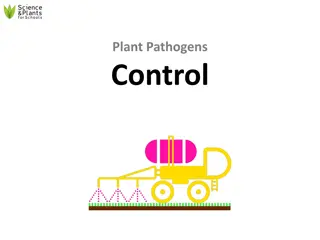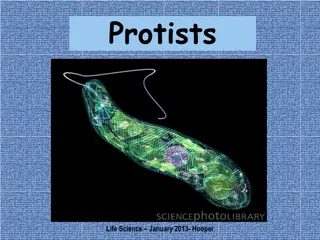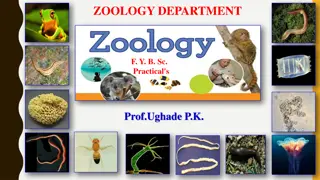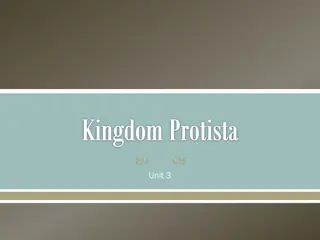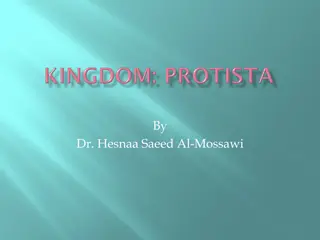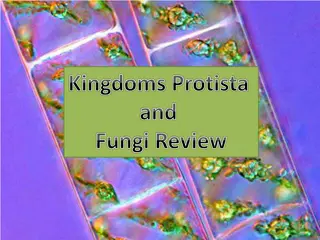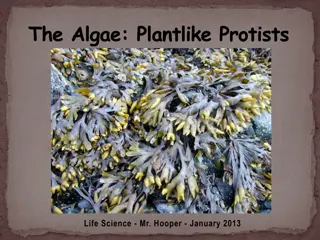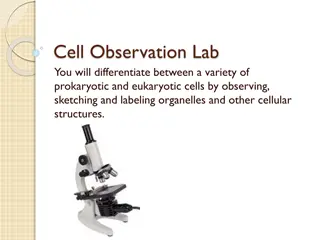Understanding Fungal and Protist Diseases: Impacts and Prevention
Fungi and protists play significant roles as pathogens, causing diseases in both humans and plants. Fungal diseases like athletes foot and protist diseases like malaria can have serious impacts on health. Control measures such as understanding symptoms, spread mechanisms, and prevention strategies a
0 views • 10 slides
Understanding the Characteristics of Living Things
Living things, known as organisms, exhibit essential characteristics including being made of cells, requiring nutrition, excreting wastes, responding to changes in their surroundings, and reproducing. They are classified into different groups such as bacteria, fungi, plants, animals, and others like
2 views • 33 slides
Understanding and Controlling Plant Pathogens for Sustainable Agriculture
Plants are essential for our survival, providing food, materials, and clean air. However, they are susceptible to diseases caused by pathogens like bacteria, viruses, fungi, and protists. These diseases can lead to reduced crop yields and increased costs. To control plant pathogens and pests, method
5 views • 28 slides
Understanding Parasitic Lifecycles and Evolution in Biology
Explore the intricate world of parasites and their lifecycles, from Protists to Bacteria, understanding how parasitism is a successful survival strategy. Discover the diversity of parasites, their lifecycle complexities, and the importance of multiple hosts in parasite development through examples l
0 views • 6 slides
Exploring the World of Protists: A Kingdom of Diversity
Protists are eukaryotes that cannot be classified as plants, animals, or fungi. They thrive in moist environments and showcase a remarkable diversity within the Kingdom Protista. From animal-like protozoa to plant-like autotrophs and fungus-like heterotrophs, this kingdom contains a wide array of un
0 views • 18 slides
Classification and Characteristics of Phylum Protozoa
Phylum Protozoa comprises unicellular, microscopic, eukaryotic organisms found mostly in aquatic habitats. They exhibit diverse locomotory structures such as cilia, flagella, or pseudopodia. These protists may possess a cellulose cell wall and various membrane-bound organelles like mitochondria and
0 views • 21 slides
Exploring the Diverse World of Protists Through Microscopic Observations
During this lab exercise, a wide variety of protists were observed, showcasing the diverse characteristics and behaviors within this group. The classification of protists is continuously evolving, focusing on convenience rather than evolutionary relationships. From autotrophs to heterotrophs with an
0 views • 20 slides
Exploring the Fascinating Kingdom Protista: Classification and Characteristics
Dive into the diverse world of Kingdom Protista, encompassing a wide range of eukaryotic organisms not classified under animals, plants, or fungi. Discover their classification based on nutrition acquisition and explore animal-like protists, such as zooflagellates, sarcodines, ciliates, and sporozoa
0 views • 21 slides
Understanding Protists: Unicellular Organisms and Their Classification
Protists are diverse unicellular organisms that can be classified based on their nutrition and movement methods. They include protozoans, algae, and heterotrophs like molds, each playing unique roles in ecosystems. From Didinium to multicellular algae, explore the fascinating world of these microsco
0 views • 8 slides
Exploring Kingdoms Protista and Fungi: Characteristics and Structures
Dive into the world of Protista and Fungi through this interactive review. Discover the unique characteristics of protists, identify different types of protists, and learn about essential structures in protists such as contractile vacuoles. Explore the significance of compounds like fucoxanthin in b
0 views • 27 slides
The Fascinating World of Algae and Protists
Algae, diatoms, dinoflagellates, euglenoids, and red algae are diverse plant-like protists crucial for Earth's ecosystems. They range from unicellular to multicellular forms, contributing significantly to oxygen production and food chains. While some like red algae thrive in deep ocean waters, other
0 views • 20 slides
Exploring the Diversity of Life: A Journey through Different Domains and Kingdoms
Delve into the fascinating world of biological diversity, from the three domains of Bacteria, Archaea, and Eukaryota to the various kingdoms within Eukaryotas like Protists and Fungi. Discover the unique characteristics and habitats of each type of organism, highlighting the importance of understand
0 views • 11 slides
Cell Observation Lab for Prokaryotic and Eukaryotic Cells
Explore the differences between prokaryotic and eukaryotic cells through a hands-on lab. Observe, sketch, and label organelles in bacteria (yogurt), protists (pond water), fungi (yeast), and plant cells (onion and anacharis). Learn to differentiate cellular structures and understand the characterist
0 views • 17 slides

